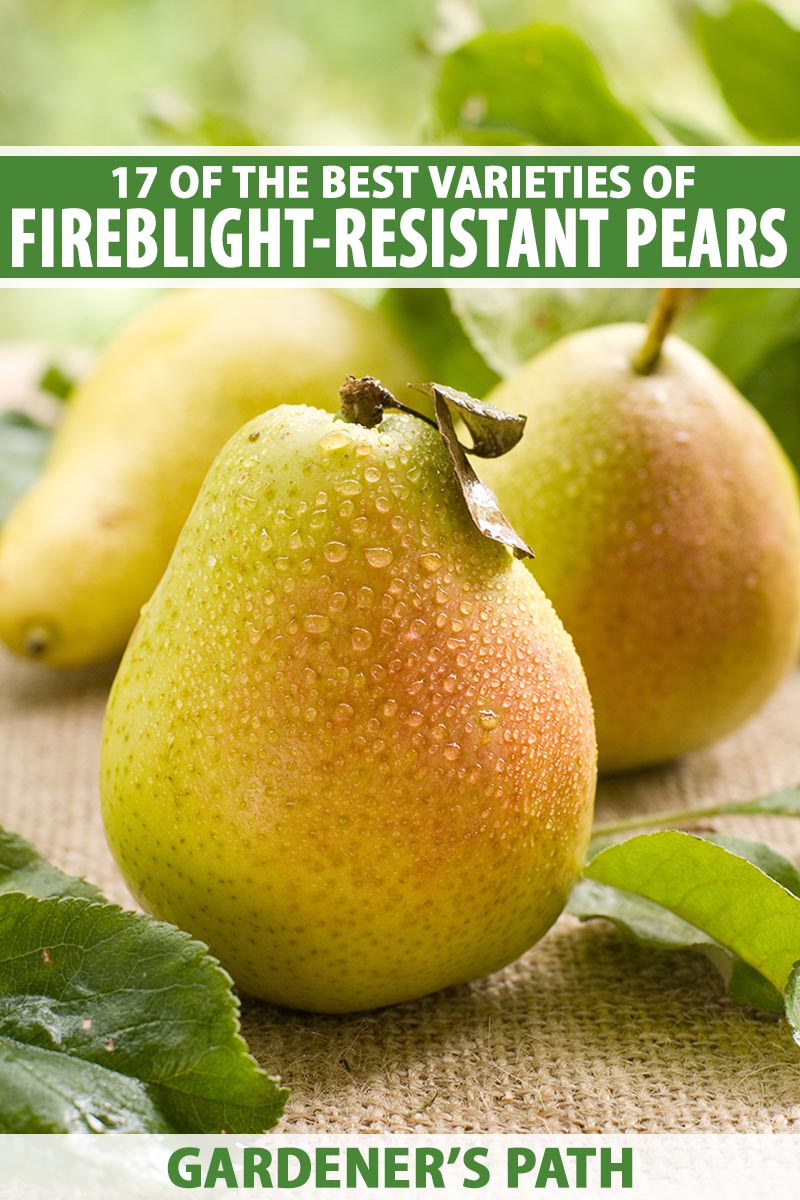[ad_1]
Fireblight is a terror. It’s a bacterial illness that infects pears, plums, apples, and different fruit bushes, reworking your plant from a luscious, productive specimen to an oozing, shriveled, blackened mess. And overlook about having fun with any of the fruits.
Fireblight is brought on by the micro organism Erwinia amylovora and is among the most devastating illnesses of pears.
When circumstances are proper for the micro organism, this illness can fully decimate a whole orchard in a single season.
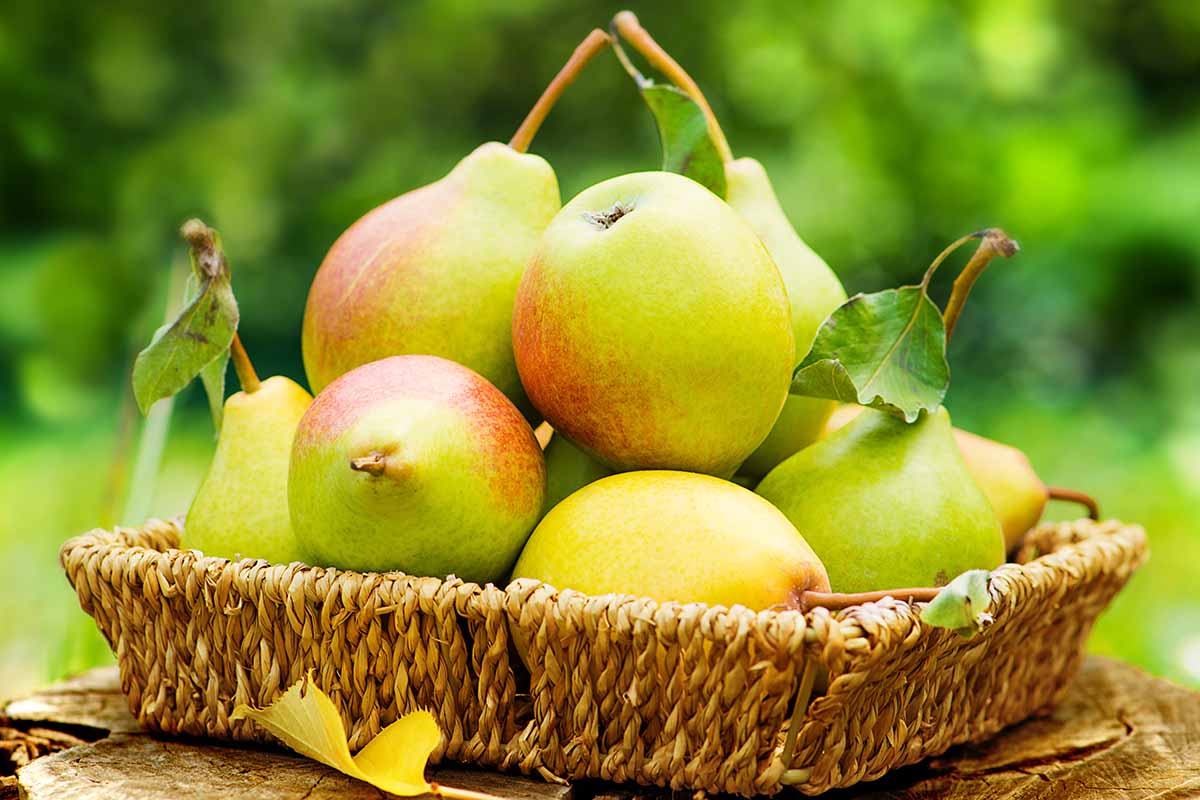
We hyperlink to distributors that will help you discover related merchandise. When you purchase from one among our hyperlinks, we might earn a fee.
It originated in North America and has unfold to the remainder of the globe, leaving consultants scrambling to seek out and breed bushes that may stand up to the results of an infection.
Plant breeders have been profitable and we’ve fairly just a few choices now which can be ready to withstand an infection. This doesn’t imply the tree is totally resistant to the micro organism, it will possibly nonetheless turn out to be contaminated, however signs are considerably diminished.
Listed here are the pear varieties value taking a look at if you wish to keep away from fireblight:
17 Fireblight-Resistant Pear Varieties
Asian pears are extra inclined to the illness than European cultivars, so that you’ll largely see the latter on this record.
Control the Ontario pear breeding program beneath Frank Kappel, Richard Layne, Harvey Quamme, and David Hunter.
They launched the Harrow sequence, which incorporates ‘Harrow Delight,’ ‘Harrow Gold,’ ‘Harrow Crisp,’ and ‘Harrow Candy,’ amongst others. All of those are no less than reasonably proof against fireblight and there are extra to return.
The West Virginia USDA breeding program beneath Richard Bell can be engaged on some choices with glorious potential that ought to hit the market quickly.
Some pears require a pollinator to supply fruits. Until we name out in any other case, ‘Bartlett’ is at all times a very good pollinator for all of the entries on this record.
It’s additionally the pear selection that growers examine others to when it comes to when the fruit ripens.
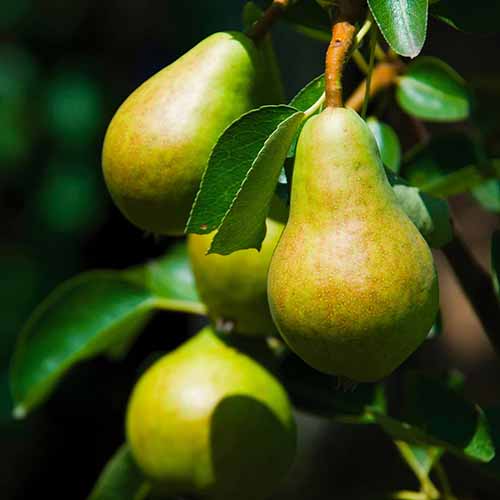
‘Bartlett’
If you wish to seize a ‘Bartlett,’ yow will discover bushes accessible at Quick Rising Bushes.
Many fruit bushes additionally require what is named chill hours. This refers to a sure variety of hours throughout the winter the place the temperature stays beneath 45°F.
Some states, like Florida, will expertise fewer than 200 hours, severely limiting which pears can develop there.
New England is safely within the 1,600+ hour class, and the Pacific Northwest has probably the most within the contiguous states at over 2,000 in most areas.
Your native extension workplace ought to have a web page devoted to the chilliness hours in your specific space.
Lastly, keep in mind that resistant doesn’t imply immune. There are not any bushes which can be resistant to the ravages of E. amylovora.
Some will present few signs, others will hardly ever have any, and a few of these choices could have reasonable signs however ought to nonetheless present fruit. Study extra about coping with fireblight in pears in our information.
1. Ayers
‘Ayers’ is a particularly fireblight-resistant pear that gives an ample harvest of enormous yellow and blush pink fruits in Zones 4 to 9.
The flesh of the medium-sized, midseason fruit is good, clean, and buttery.
This USDA Agricultural Analysis Service-bred tree is self-fruitful however rising a pollinator pal will improve yields. Launched in Georgia in 1976, it shortly turned a favourite for rising within the south and goes by the nickname “sugar pear” for its candy taste.
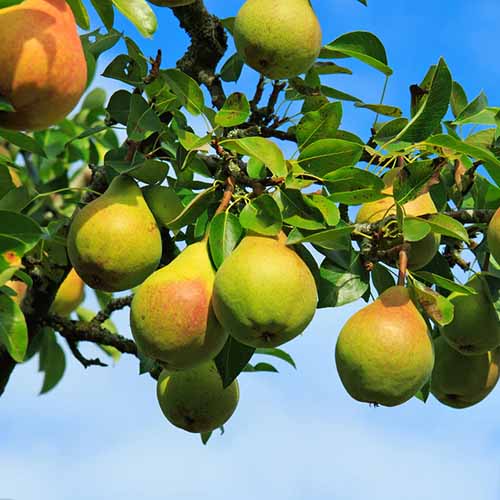
‘Ayers’
It solely wants about 300 chill hours, making it a good selection for areas with hotter winters in USDA Rising Zones 5 to 9.
You’ll find ‘Ayers’ in five-gallon containers accessible at Excellent Crops Nursery.
2. Blake’s Delight
‘Blake’s Delight’ was bred by the USDA and Ohio State College and launched in 1998 for Zones 5 to 9.
It’s extremely proof against fireblight and is commonly the one growers suggest for gardeners who’ve battled fireblight prior to now.
When you’ve ever tasted a ‘Comice’ pear, the flavour is analogous. The big, yellow-skinned fruit is good and juicy with a buttery texture.
The fruit shops for months and ripens two weeks after ‘Bartlett,’ making it a mid-late sort. It wants about 750 chill hours and isn’t self-fertile, so it would require a pollinator.
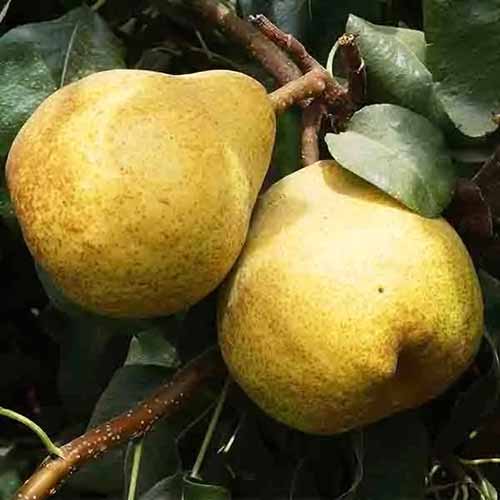
‘Blake’s Delight’
It’s additionally tolerant of warmth, which makes it excellent for areas with sweltering summers that trigger many pears to falter.
You’ll find ‘Blake’s Delight’ accessible from Nature Hills Nursery in #3 containers.
3. Elliot
Now we have consultants from the College of California in Davis, led by Dr. Kay Ryugo to thank for ‘Elliott,’ which they launched in 1987 after hybridizing ‘Elliot No. 4’ and ‘Vermont Magnificence.’ It was bred primarily for its resistance to fireblight.
The flowers would possibly flip black however the an infection sometimes doesn’t proceed past that and the fruit develops usually.
This cultivar begins fruiting as younger as three years outdated, at which level you’ll be able to benefit from the yellow fruits with mild russeting which have a wonderful steadiness of sugar and acidity. It’s akin to the beloved ‘Bosc’ in taste.
‘Elliot’ shops properly and might last as long as 4 months in storage. It’s a midseason sort and wishes a pollinator accomplice. Develop it in Zones 5 to 9 the place the tree will obtain about 600 chill hours.
4. Farmingdale
‘Farmingdale’ is a type of uncommon cultivars that isn’t the results of intentional hybridizing, however an opportunity seedling with ‘Benjamin Buckman’ parentage on the Oregon State College Agricultural Experiment Station.
Along with proving to be extraordinarily proof against fireblight, it’s additionally powerful sufficient to not succumb to collar rot.
The midseason fruits have yellow-green pores and skin with mild russeting wrapped round white, juicy, buttery flesh.
It isn’t thought-about one of the vital flavorful pears, however the tree’s vigor, uniform progress, and illness tolerance makes it an interesting possibility.
‘Farmingdale’ can be chilly hardy, rising in Zones 4 to eight. It has been used recurrently as a father or mother to breed new blight-resistant cultivars and as rootstock for hybrids.
5. Harrow Delight
‘Harrow Delight’ lives as much as its identify. The large harvest is pleasant, as is that this plant’s resistance to fireblight and scab. To not point out the candy, juicy fruits.
This cultivar wants about 800 chill hours and don’t be shocked if it blooms prolifically one 12 months and fewer so the following 12 months. It’s hardy in Zones 5 to eight.
It’s not self-fruitful, so that you’ll must plant a pal. ‘Harrow Delight’ is within the late blooming group, however the fruits ripen early – prepared two weeks earlier than these of ‘Bartlett.’
Eat the fruits recent or course of them instantly as they don’t retailer properly.
6. Hood
Concern not, truthful climate readers. ‘Hood’ is completely satisfied in heat climates, together with Zones 7 to 10, and solely wants 100 or so chill hours.
Though it’s partially self-fertile, discover it a pal and also you’ll have an much more ample harvest.
Talking of, the fruits are candy, buttery, and aromatic with a greenish-white pores and skin and white flesh.
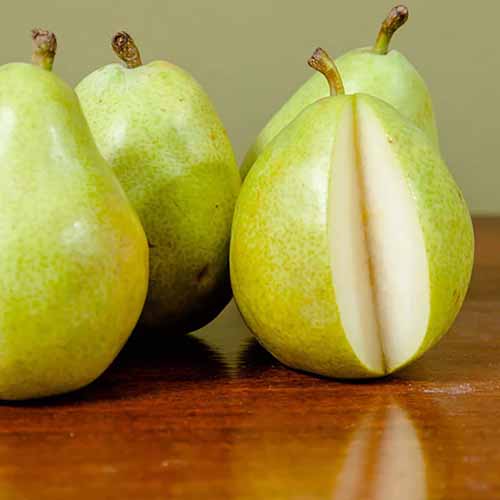
‘Hood’
That is an Asian pear cultivar and requires a fellow midseason pollinator. Whereas the bushes could be topic to leaf spot, fireblight is a uncommon challenge.
You’ll find five- to six-feet-tall bushes accessible at Excellent Crops Nursery.
7. Kieffer
Consultants aren’t one hundred pc certain the place ‘Kieffer’ originated, however it’s possible a pure hybrid cross between a Chinese language and a European pear.
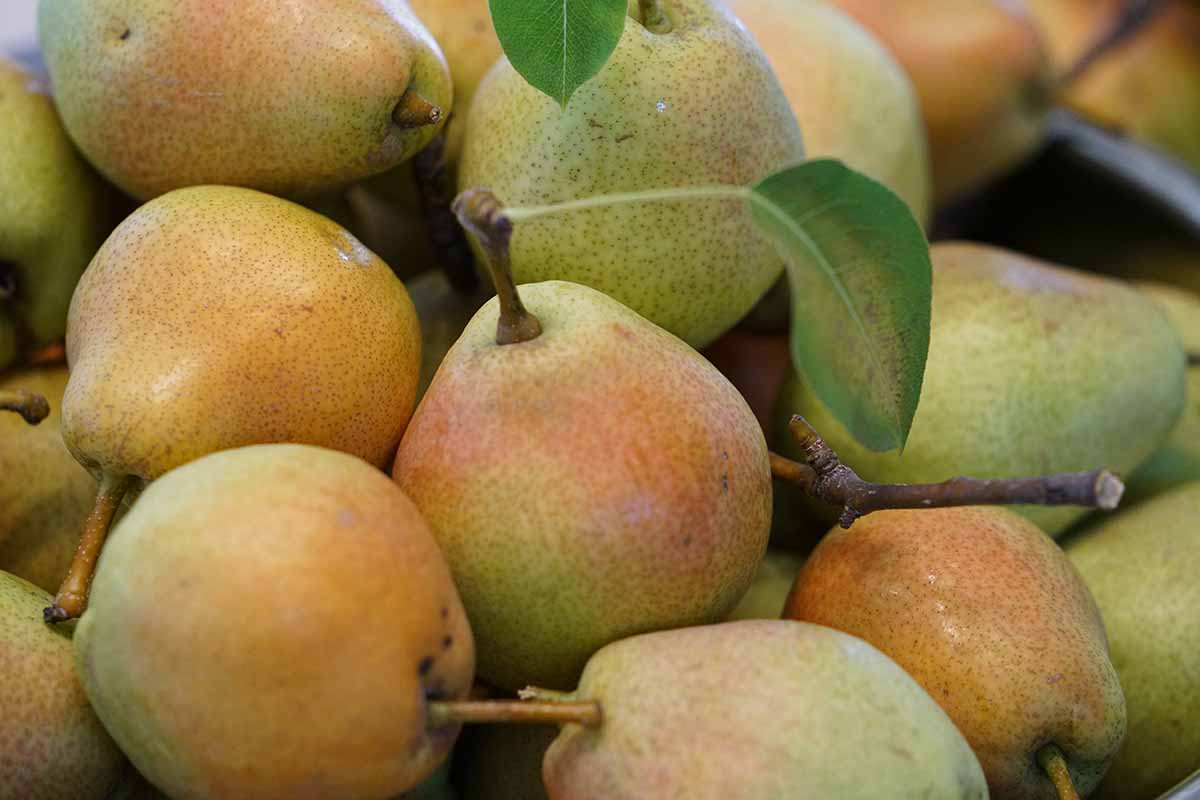
It was launched by breeder Peter Kieffer in Philadelphia someday within the late 1800s. The massive, juicy, wealthy, and candy fruits are a manna from heaven and a favourite of business growers for canning.
‘Kieffer’ is prepared to reap a full month after ‘Bartlett,’ however it’s an early-midseason bloomer, excellent for Zones 5 to 9. Not solely is it adaptable to many various climates, however it additionally has a low chill requirement of simply 350 hours.
The fruits are medium-sized and considerably tart with a crispness that hints to its P. prunifolia ancestry.
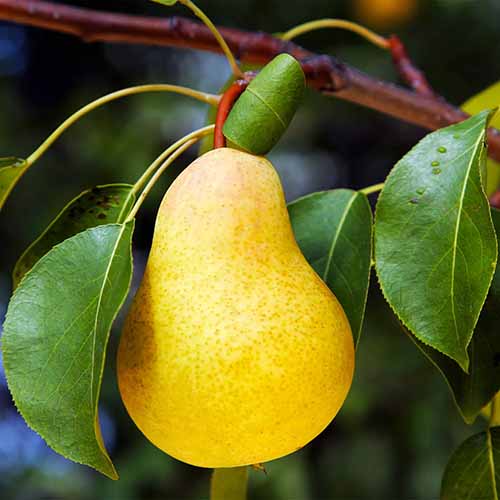
‘Kieffer’
The pores and skin is golden with blush pink round white flesh. It has a wonderful shelf life and excessive yields even and not using a pollinator.
So far as fireblight-resistant choices go, this one ticks all of the containers. It’s accessible from Quick Rising Bushes in a wide range of sizes.
8. Magness
Once you ask pear consultants about fireblight resistant cultivars, ‘Magness’ will undoubtedly prime the record. This tree was bred by the USDA’s Maryland Agricultural Analysis Heart in 1960 with ‘Seckel’ and ‘Comice’ parentage.
It has confirmed over the many years to be just about resistant to the illness when the micro organism enters the shoots and flowers.
The illness can nonetheless enter by way of wounds, so take care when pruning or working round it (and all fruit bushes). It’s additionally proof against scab and mildew.
‘Magness’ can’t be used as a pollinator as a result of its pollen is sterile.
When you select this one, you’ll positively must plant a pollinator that may develop together with it in Zones 5 to 10 and that blooms in midseason.
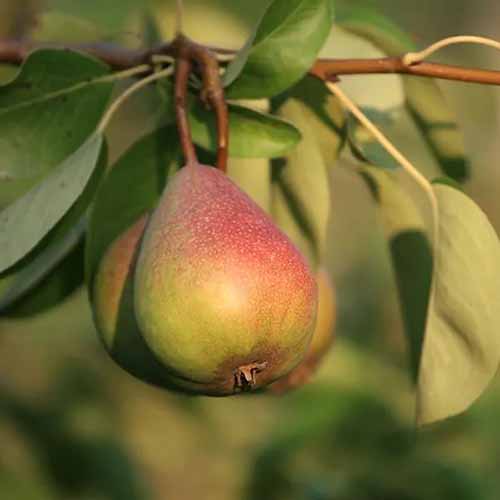
‘Magness’
Ensure your area has no less than 400 chill hours so the tree can produce fruit.
As soon as they mature, the fruits can retailer for months and are extraordinarily flavorful and candy, with a honeyed, buttery, candy flesh with completely no grit.
The pores and skin is a ravishing yellow with a crimson blush and is kind of thick, which is a plus each for storage capabilities and avoiding harvest harm.
You’ll find ‘Magness’ pears accessible from Nature Hills Nursery.
9. Maxine
‘Maxine’ is an heirloom cultivar found in Ohio in 1930 by horticulturalist E.M. Buechly of Greenville, Ohio, and generally offered beneath the identify ‘Starking Scrumptious’ or ‘Century Yellow.’
The fruits are golden inexperienced with mild russeting, and inside is buttery, juicy, flavorful flesh. ‘Maxine’ bushes are extraordinarily vigorous,disease-resistant, and hardy in Zones 4 to 9.
Discover this midseason bloomer a pollinator pal and ensure it receives about 700 chill hours.
10. Moonglow
Of all of the pears on this record, ‘Moonglow’ is among the most fireblight-resistant. The fruits are delicate and candy, with little or no acid, they usually’re prepared early within the 12 months. You could be digging in a full week to 12 days earlier than ‘Bartlett’ is able to harvest.
The feel is heavenly, with all of the softness you need from a dessert fruit however not one of the mushiness that may generally accompany it.
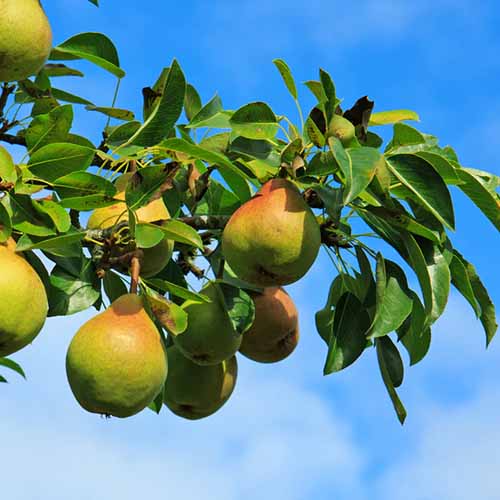
‘Moonglow’
’Moonglow’ was bred by the Beltsville Agricultural Analysis Heart in Maryland in 1960 and offers an enormous yield of candy fruits in Zones 5 to 9. Make certain your space has no less than 500 chill hours to offer this tree with what it must thrive.
It wants a pollinator companion and, on that observe, additionally works as an distinctive pollinator for different cultivars because of its long-lasting midseason blossoms.
You’ll find ‘Moonglow’ in a wide range of sizes accessible from Excellent Crops Nursery.
11. Orient
This vigorous tree produces spherical, yellow fruit with a touch of blush pink that’s as fairly as it’s tasty.
The pores and skin is skinny and golden round juicy, creamy, grit-free flesh with an intensely candy taste.
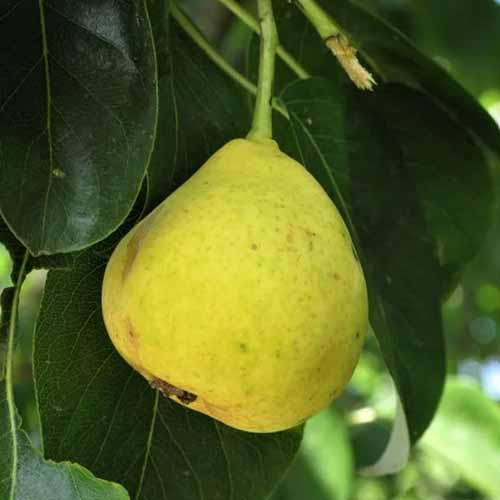
‘Orient’
Gardeners in Zones 4b to 9b can develop this European hybrid. It’s partially self-fertile however will produce a bigger harvest with a pollinator pal.
‘Orient’ is a mid- to late-season sort that wants 350 chill hours.
You’ll find bushes in three-, five-, seven-, and 10-gallon pots accessible by way of Walmart.
12. Potomac
The USDA Agricultural Analysis Heart collaborated with Ohio State College to breed ‘Potomac’ from a cross between ‘Moonglow’ and ‘Anjou’ and launched their creation in 1993.
On that fortunate day, we had been gifted with an distinctive disease-resistant possibility.
The fruits are extraordinarily fragrant, with a candy, subtly acidic, buttery, tremendous juicy middle. The pores and skin is shiny and light-weight inexperienced with only a little bit of russeting and blush pink.
It matures about two weeks after ‘Bartlett’ in Zones 5 to eight and might retailer for 2 months. ‘Potomac’ wants a pollinator pal and no less than 600 chill hours.
13. Seckel
Choose your pears tremendous candy? Then decide the one nicknamed “sugar” and “sweet.”
This heirloom originated in Pennsylvania within the late 1700s from an opportunity seedling, and has confirmed again and again to face powerful in opposition to E. amylovora.
The candy and barely spicy fruits ripen a few week after ‘Bartlett’ and are extraordinarily small, however boy are they flavorful, and the tree produces an ample harvest.
Plus, they’re very fairly with olive inexperienced pores and skin and a maroon blush.
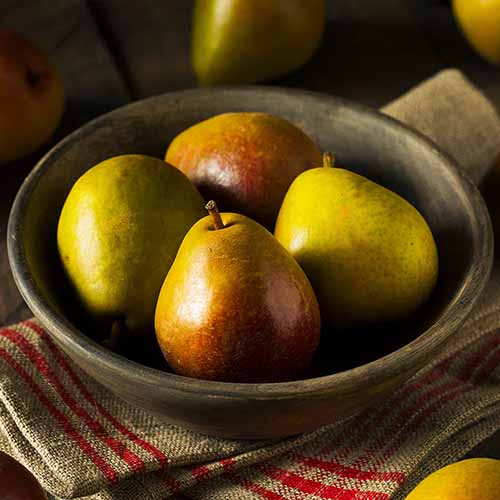
‘Seckel’
Seize an ‘Ayers,’ ‘Keiffer,’ or ‘Moonglow’ as a pollinating pal for this midseason bloomer, although it’s partially self-fertile. It wants about 500 chill hours to supply.
My mouth is salivating simply occupied with the juicy crunch. Begin your individual provide by buying a three- to four-foot-tall tree from Quick Rising Bushes.
14. Shenandoah
‘Shenandoah’ produces enormous fruits, the biggest on this record, that retailer for as much as 5 months, and have a very good steadiness of acidity and sweetness. The wealthy taste mellows out in storage.
Along with fireblight resistance, this one can be proof against scald.
This cultivar was bred by the USDA Agricultural Analysis Heart and Ohio State College, led by horticulturalist Richard Bell, and hit the market in 2002. It’s a hybrid cross of ‘Max Purple Bartlett’ and an unnamed seedling.
The fruit is prepared for harvest about 5 weeks after ‘Bartlett,’ making it one of many newest to ripen on this record.
Whereas it doesn’t require a pollinator, planting one will improve yields. It wants about 600 chill hours in Zones 5 to 9.
15. Shinko
Of the Asian pear cultivars, ‘Shinko’ has the very best popularity for being fireblight resistant.
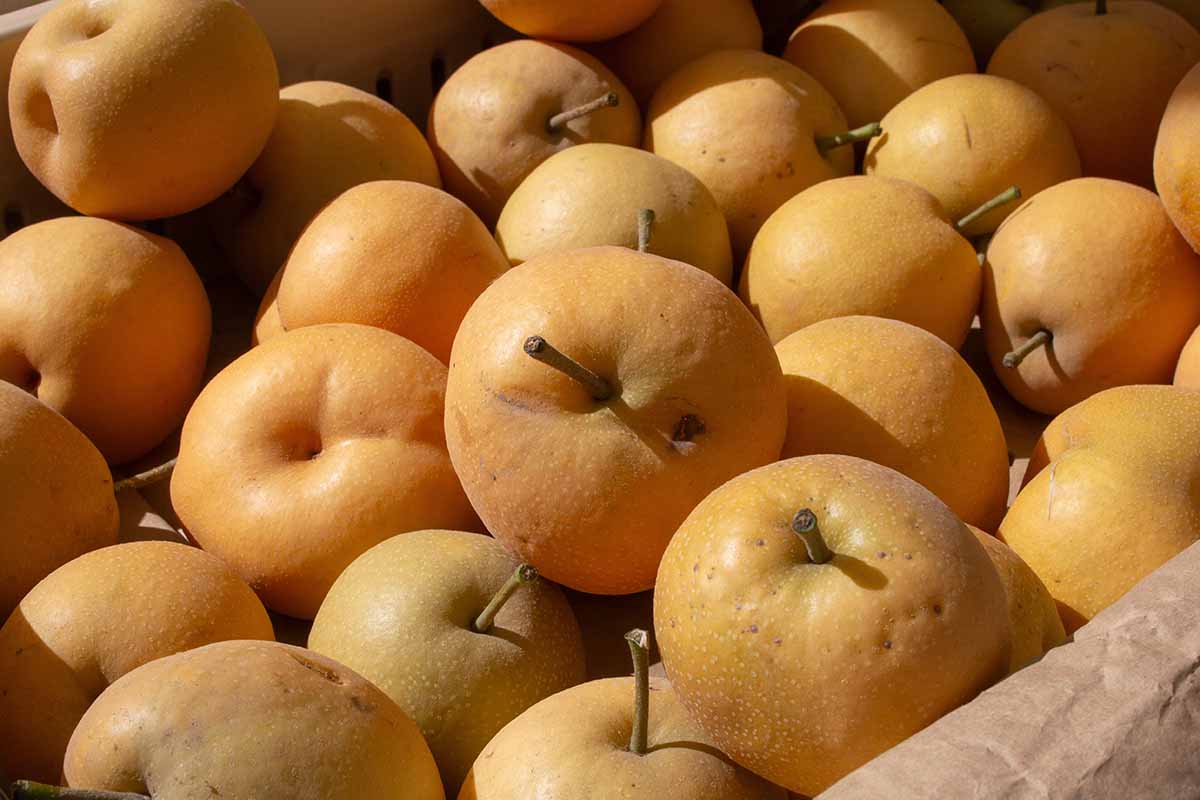
Launched in 1941 in Japan, its identify means “new success” and its illness resistance together with ample harvest, massive fruits, and vigorous progress actually reside as much as that identify.
It’s a cross between ‘Nijisseiki’ and ‘Amanogawa,’ two standard Japanese Asian pears.
Although it’s self-fertile, a midseason Asian pear pal will improve your yields. It requires about 450 chill hours in Zones 4 to 9.
The apple-shaped fruits ripen in late summer season and they’re wealthy and candy with a brownish-green pores and skin.
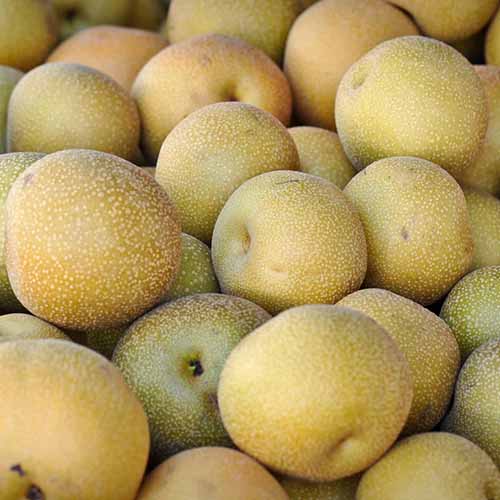
‘Shinko’
If you wish to take pleasure in Asian pears with out the specter of E. amylovora, that is your best choice.
Choose one up at Excellent Crops in a five-gallon container.
16. Tyson
A variety of fireblight resistant pears are fashionable hybrids, however ‘Tyson’ is an heirloom cultivar that has been round since 1794 when it was found on a farm in Jenkintown, PA.
It ripens early, about two weeks earlier than ‘Bartlett’ and has glorious resistance to fireblight, in addition to the power to develop in chilly areas. As a result of it likes the chilly, ‘Tyson’ additionally has excessive chill necessities, with about 700 hours or extra vital for ample fruiting.
The pears are petite, however there’s nothing tiny in regards to the taste. The fruits are grit-free, wealthy, candy, and intensely juicy as long as they’ve a pollinator companion close by.
The fruits don’t hold properly, so eat them recent or can them shortly. This cultivar is appropriate for rising in Zones 4 to eight.
17. Warren
‘Warren’ is known as after its creator, Thomas O. Warren, who bred this tree in Hattiesburg, Mississippi, and launched it to market in 1976.
The fruits are extraordinarily flavorful and a number of the best-tasting I’ve come throughout, with a wealthy, candy taste and buttery texture. They’re prepared by late summer season, per week after ‘Bartlett,’ in Zones 5 to 9 and solely want a modest 600 chill hours.
The tree is extraordinarily proof against fireblight and is among the greatest choices in the event you’re struggling to maintain the illness out of your backyard.
‘Warren’ requires a pollinator to supply fruit, and moreover the pollen it produces is sterile, so it will possibly’t pollinate different bushes.
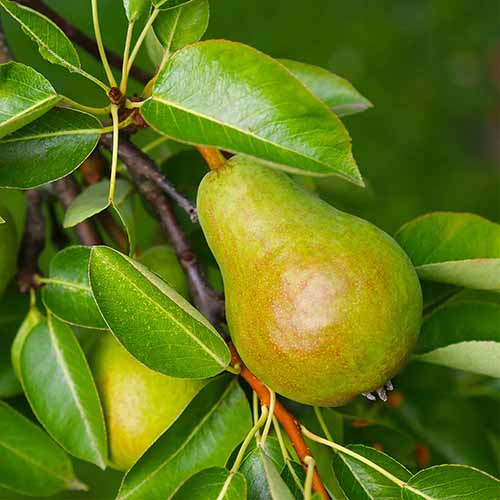
‘Warren’
Meaning you’ll want three bushes in the event you select to develop ‘Warren.’ The tree itself, one to pollinate it, and one to pollinate its pollinator. Think about the bounty!
The fruits retailer for as much as three months, so you’ll be able to benefit from the distinctive taste into winter.
You’ll find ‘Warren’ accessible at Quick Rising Bushes.
Cool the Hearth
Fireblight is an terrible illness, and since there isn’t any treatment, we’ve to develop resistant cultivars.
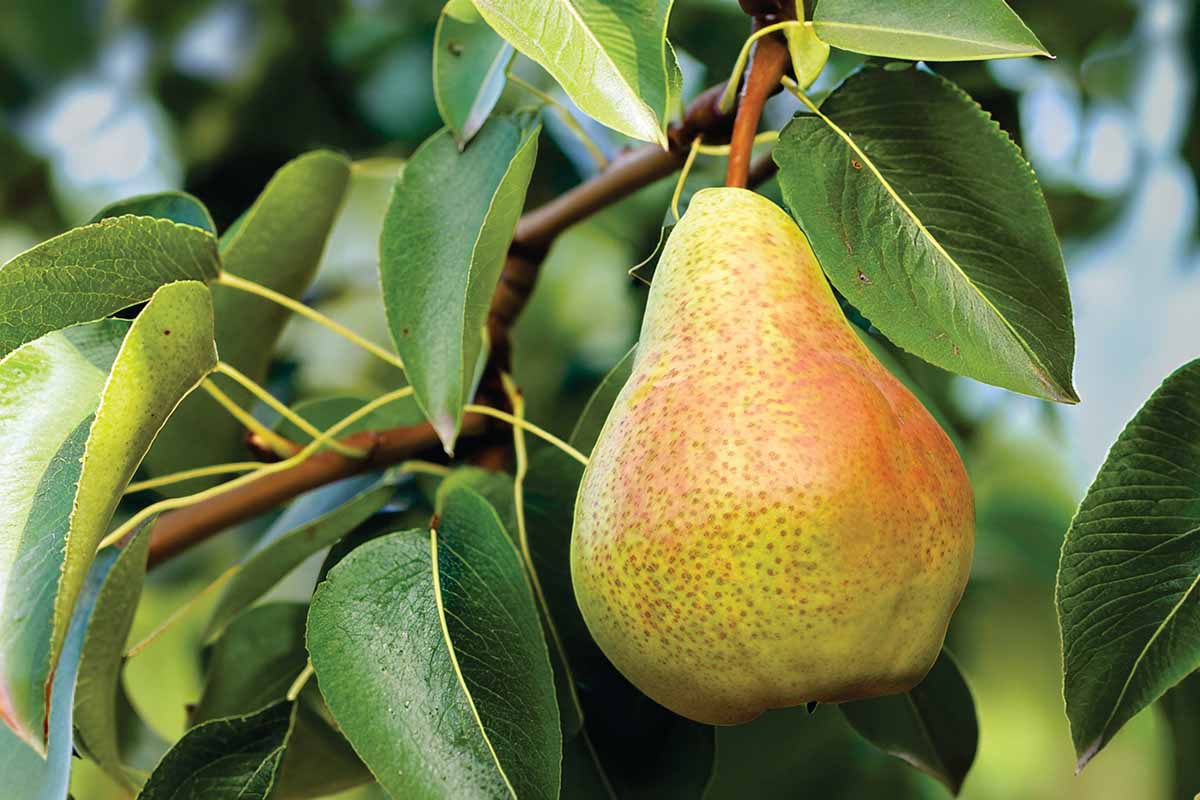
All the pears on this record have sufficient resistance to the pathogen that even when they do turn out to be symptomatic, the illness will progress so slowly you could prune out the infested areas and save the tree.
Which one among these do you suppose you’ll go along with? Have you ever been combating fireblight in your backyard? Tell us what’s up within the feedback part beneath.
And for extra details about rising pears, have a learn of those guides subsequent:
[ad_2]



